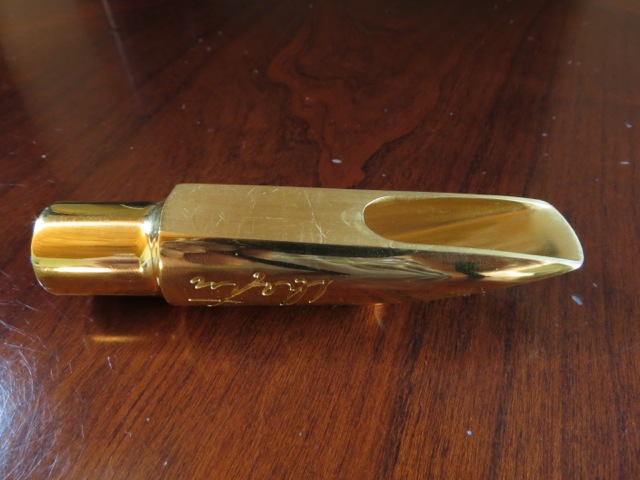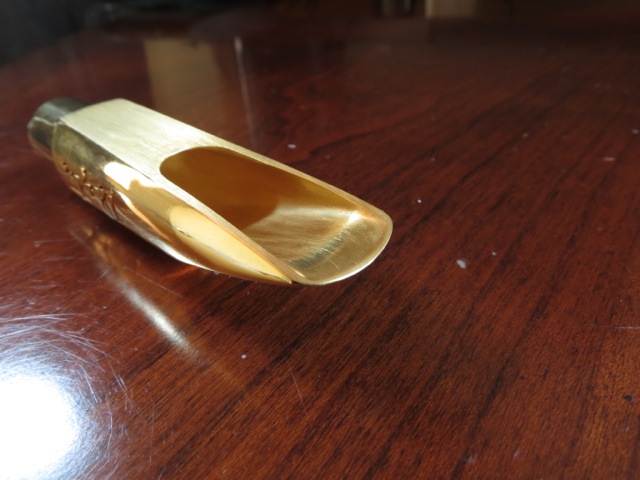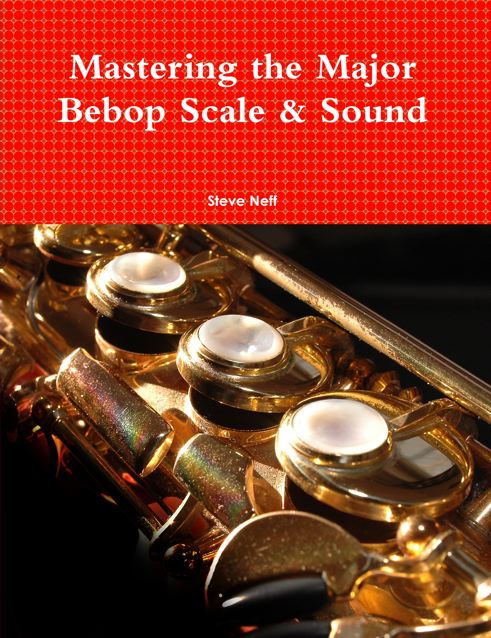Today, I am reviewing another RS Berkeley Legends tenor saxophone mouthpiece that was sent to me by Les Silver at RS Berkeley. RS Berkeley has come up with the revolutionary idea of trying to find mouthpieces that were played and loved by jazz legends (deceased and still living)………and then copying them exactly so that we could try an exact replica of the mouthpiece that one of our hero’s played. It’s an exciting concept (yet very scary because if we play the exact mouthpiece our hero played and still sound like crap ……….well, let’s just say it’s a wake up call……..)
I have previously reviewed two RS Berkeley Legend mouthpieces when they used to be made by Drake Mouthpieces (current RS Berkeley Legends mouthpieces are no longer made by Drake……….), the Stan Getz model and the Bird model (Charlie Parker played this one……) This new one is the Dexter Gordon model.
RS Berkeley Legends Dexter Gordon Tenor Sax Mouthpiece
The first thing that amazed me about that Dexter Gordon model tenor sax mouthpiece is that it has a .080 tip opening! This is quite small in relation to modern tenor saxophone tip sizes so I thought it was a mistake. I emailed Les at RS Berkeley to make sure this was correct and he said that the mouthpiece Dexter was playing that they copied was indeed a .080 tip opening. WHAT!!! Dexter with the hugest sound on the face of this earth was playing on a 5 tenor mouthpiece!!……….Impossible! (OK, maybe Dexter was just awesome!!!!)
Here is a snippet from the RS Berkeley website on the Legends mouthpieces:
“Legends Series mouthpieces are officially licensed reproductions modeled after the originals used by the world’s most iconic musicians. Production of the Legends Series line begins with and features 3D scanning and post processing services by Konica Minolta’s 3D Scanning Labs, state of the art laboratory. Konica Minolta technicians take highly precise scan data, which captures the unique characteristics of each original mouthpiece, enabling them to match the exact geometry of the original. Once the scan is completed, the data is paired with specialized software to clean, align and create high quality CAD models. From an archival standpoint, Konica Minolta’s 3D scan models of the mouthpieces are exact representations of the original. The entire process is overseen by RS Berkeley’s master mouthpiece maker and designer, Jack Onque, who oversees every element of production from design to finishing, ensuring the highest quality and accuracy of each reproduction.”
RS Berkeley Legends Dexter Gordon Tenor Sax Mouthpiece
I took the Dexter Gordon model out of the shipping container and saw that it had signs of wear and tear. I believe this was a prototype that they ship around to players so they can try it out. It had a multitude of scratches and scuff marks on it as you can see from the pictures.
It has nice even side rails and a thin tip rail. The Dexter Gordon model has a rollover baffle that slides down into what I would consider a large chamber. The side rails are scooped out and the chamber is smooth with no imperfections. The side of the mouthpiece is engraved with “DEXTER” in cursive engraving.
RS Berkeley Legends Dexter Gordon Tenor Sax Mouthpiece
How does the Dexter model play? Well, I have to admit that my preconceived idea of it was that it just wouldn’t work for me. I don’t think I have ever played an .080 tip on the tenor saxophone except when I reviewed the RS Berkeley Drake Stan Getz model (which also was a pleasant surprise……). You always hear stories of your heroes playing small tip size mouthpieces and think……..that’s impossible! How did they get that huge sound on a .080 tip? (admit it you have thought this…….)
The review of this mouthpiece wasn’t easy for me. All of my reads are 2 1/2 and 3’s for the most part. I tried a few of those and they played like a wet paper towel would. The 3 1/2’s weren’t much better. I had to dig down into the dark recesses of my reed reserves…………. I found a number of old Vandoren ZZ 4’s that I had from around 12 years ago. I had to dig them out of my reed vault and clean the cobwebs off them. I tried a couple and the third one was the charm. This is the one I used on the recording and I felt it worked well with this mouthpiece.
RS Berkeley Legends Dexter Gordon Tenor Sax Mouthpiece
The first thing I was surprised by was the volume I could get out of this mouthpiece. This was no pea shooter sounding mouthpiece. I could get respectful volume out of it. Even to the point of I dare say a “wailing” volume. The highs had a nice brightness to them that rang out and the lows were fat and full. I do think this recording is a great example of the focus and core a smaller tip opening can give to a sound. To me, it has a nice round core of compressed sound that is rich and powerful. If you listen to my clips of more open mouthpiece I think you can hear that the tone is a little more spread and diffuse in comparison to this sound clip perhaps. That’s my impression anyways. Also, the altissimo notes were beautiful, sweet and round sounding which they usually aren’t on wider tip openings…..
The RS Berkeley Dexter Gordon Legends series tenor saxophone mouthpiece was great to play. If you like the sound of the clip below and the mouthpiece catches your interest then give it a try. You can contact Les Silver at his website at http://www.rsberkeley.com/ Tell him Steve sent you………….Great work Les and everyone at RS Berkeley!!
Let me know what you think in the comments below. Thanks, Steve
RS Berkeley Legends Dexter Gordon Tenor Sax Mouthpiece







Great sound, Steve. Nice focus without rough edges. Was this done on your (regular) SELMER SBA tenor? That might explain the “focused” sound. Try it with a Conn 10M. The result might be different.
Anyway the sound wasn’t too dark. Rounded focused sound good for traditional jazz.
Hi Adrian,
Yes, that clip was done on my normal SBA. I used to have a great 10M years ago but sold it along the way………..
Steve!
I can’t believe I just found your website. We briefly played together in a sax quartet with Patrick Osbourne like a decade ago. You sound great – thanks for the Dex mpc review. Glad to see things are going well for you.
Hope to get to play with you again someday,
Larry
Larry, It’s good to hear from you. I remember playing with you guys. That was a lot of fun. I would love to play again but now I’m way up in northern Vermont about 3 hours from you……….. I hope things are going well and you’re still playing!!
Hi Steve I found this interview Dexter did with Les Tomkins in the early 60’s-
‘Do I have more technique and facility now than in those earlier years? Yes, I think so. I’ve made very few changes in mouthpieces and reeds. During the time of “The Chase,” I had an Otto Link mouthpiece which had been made for me and I used that until it got stolen around ‘52 or so. That’s when I got the mouthpiece I have now. However, they’re both metal mouthpieces. So in the last 17 or 18 years or so I guess I’ve had just the two mouthpieces.I use a medium strength reed. I’ve been using a La Voz for several years. It’s made in California and I think it’s the best reed on the market myself. It’s pretty consistent……Actually this present mouthpiece of mine is relatively small. It’s just medium–size—a five–star. It’s been straightened out a little bit, but it’s not a big mouthpiece. It blows very free and gets a nice substantial sound. Most people are surprised because they think it’s a much larger mouthpiece than it is. They think it’s maybe an eight or nine or something like that, but it’s not. So that’s why I say it’s the projection that counts.’
Thanks James. I appreciate the quote from the interview and just found it online after you posted. http://www.nationaljazzarchive.co.uk/stories?id=334
One paragraph that is interesting that was left out of the quote above is:
“I kinda feel sorry for guys that constantly go through the mouthpiece and reed scene. I wonder how they do it. It must be a real panic scene. Naturally the mouthpiece, the reed and the horn you use are all very essential, but basically your tone, your sound is inside of you. You hear it before you produce it. The real ingredient of the sound is within the individualthe way he hears things.”
So I’m not sure what mouthpiece he is talking about that is a 5* but Dexter’s sound in the 60’s was killer and if he said he played on a 5* at least that is proof that it can be done on that smaller tip…………
Hey Steve,
DAYUM! This is as good as I have ever heard you. Sounds incredible. Is a switch to a .80 tip opening in your future? Jeff
Hi Jeff,
Although it felt good to play it and I liked the sound a lot I think I will stick with my 7* tips. The true test is going out and using it on a gig……….
Hi Steve,
love reading your mouthpiece reviews, this is just interested to see what your favorite mouthpiece is.
Andrew,
I’m sort of like Jay Leno with cars! He has a ton of cars that he collects and I have a ton of mouthpiece that I have. I don’t really have an over all favorite but I do have favorites in different categories. When you are dealing with well made mouthpieces I find that many can do the job and play great and they each have their own personality and strengths that I like. All a bit different and unique. Steve
What I miss in this review is how Dexter played on his mouthpiece. As far as I know he played with his underlip not folded but wide open. That explains the typical rough Gordon sound. The tip of a mouthpiece is a very personal thing. I play with a very small tip opening since I was 12 and still cannot handle wider tips……..
Yes, that is true. I did a series of lessons on Dexter playing Lady Bird where I talk about the video of him playing and what it reveals……….If you do a search on the site for “The Style of Dexter Gordon” you should find it. Steve
Thanks Steve, great!
If you don’t want to get the lesson or transcription just do a search on Youtube for Dexter and Lady Bird. The video is killin’ and shows close ups of his embouchure. Steve
Thanks, it’s over obvious, I can’t play like that, you?
Thank you, Steve, for bringing this mouthpiece to my attention. I love Dexter and need to try his model mouthpiece. I play a Berg Larsen 110/1M but it’s a bit bright, although I love the way it projects. The Dexter model will equal the projection and dim the brightness considerably. I’m going to contact Les Silver and try out the mouthpiece. Thanks again! Sky bless you!…
Steve, thanks for the great review of LTD’s mouthpiece replication. I’m uncertain if you addressed the ligature you used with your set-up with your review and audio. Are you able to share that?
Thanks,
Paul Schneidmill
Yes, I had to listen back to the audio clip but I say I am using a Selmer 404 metal ligature on this demo. Steve
Hi Steve,
on my strange looking finger placement: It is because of playing a Conn 10m which is not made for the “balanced action” of a jazz musician.
Thanx for Your great idea of anylizing my style and share it.
Keep on.
Dexter
Is this really Dexter reaching out from the other side?? So cool! Miss you Dexter!!
Steve, I’ll be always with You all.
check https://www.youtube.com/watch?v=EBQ3oehQJMM
at 17:23 to see my left hand finger placement on a Mark 6.
Dexter
Hi Steve!
Dexter has been my greatest idol since I first started to listen to jazz, before I started to play sax myself. It’s hard to resist trying this mouthpiece! It’s quite expencive though, and I’m sort of happy with my current mouthpiece (Aizen LS Kurogane 8), but when I can’t resist any more, when my curiosity finally crushes my financial discipline (which I don’t have at all…) which one would you recommend me trying? The original one with the small opening 0.80″ or the more medium sized 0.100″ that is also availiable?
What are the possible possitives and negatives whith a smaller opening?
/per
I personally really dug the smaller tip opening. I also tried the .100 tip opening but did the review on the .080 because I liked it more. I felt like it had more of that focused Dexter vibe to the sound. The problem with a smaller tip opening is that you can only get so much air though the opening so volume might be an issue if you play in loud playing situations. At the same time, with a smaller tip you can usually play on harder reeds so many times you can get more volume from the harder reeds. Bottom line, you have to try it for yourself to find out if it will work for you. Steve
Always love your reviews!
I’ve got a question on small tips and soft reeds….
What is it about your approach to embouchure that you find small tips needing much harder reeds?
Are you biting or using a lot of lower lip pressure?
Thanks Steve!
Swerdy, I wouldn’t say this is my approach but rather it is common among all sax players to experience this. If I play on a 7* tenor mouthpiece (.105) and use a 2 1/2 reed, that same reed will feel much softer on a 6 tip opening (.090). The reed is a lot closer to the tip rail and doesn’t have to bend as far to make contact with it which makes it easier to blow. Many times when I play a smaller tip a reed that is too soft, it will feel like a wet noodle. It will have no character to the sound and will be really bright and “blatty”. It will many times close up when I blow hard also. I don’t believe I bite or use too much lip pressure but my embouchure follows what I have been taught by the great sax teachers I have had over the years. Hope this answers your questions. Steve
Hello Steve,
There is a 7 tip available of the same mouthpiece available, ever tried that one?
How can we be sure that this is an exact copy of the Dexter Gordon mouthpiece? I suppose it’s a copy of the Dukoff mouthpiece and not the Link he played on in the seventies?
Leo
Hi Leo, I only reviewed the .080 because that was the exact copy of the Dexter mouthpiece which was also at .080. Obviously the .100 is not an exact copy as far as tip opening and facing curve but I believe the chamber and baffle are the same as the original piece. I think RS Berkeley made this piece to attract more players that play in the .100-.105 range of tip opening. When you change the tip opening and facing curve you get a piece that plays differently than the original obviously. Not saying it is better or worse but just different. Steve
Hi Steve, Looking for news of Dexter Gordon on Wikipedia I also find what, if legal, I would report with copy paste. From:
https://en.wikipedia.org/wiki/Dexter_Gordon
“… Instruments and mouthpieces
The earliest photographs of Gordon as a player show him with a Conn 30M “Conqueror” and an Otto Link mouthpiece. In a 1962 interview with the British journalist Les Tomkins, he did not refer to the specific model of mouthpiece but stated that it was made for him personally. He stated that it was stolen around 1952. [1] In the Tomkins interview he referred to his mouthpiece as a small-chambered piece with a 5 * (.085 under the Otto Link system) tip opening. He bought a Selmer Mark VI from Ben Webster after he lost his 10M during the trip to Paris. In a DownBeat magazine interview from 1977, he referred to his current mouthpiece as an Otto Link model with a # 8 (.110 under the Otto Link system) tip opening. [7] …”.
It appears to me that the mouthpiece that Dex played before it was stolen from him with his Conn was a Dukoff 0.080 tip opening as well as certifying, for the tip opening, the copy made by the “RS Berkeley Legends Dexter Gordon Tenor Sax Mouthpiece” that you are here reviewing. Also I think the sax and mouthpiece were stolen from him around 1964 and not 1952.
As for the reference to the Dukoff I think it is true what, if lawful, I post by taking it from youtube where Dex plays what seems to me his Conn with the well framed Dukoff mouthpiece, Lady Bird, concert dated 1964 (he still had the Conn and, therefore, it could not have been stolen from him in 1952):
https://www.youtube.com/watch?v=r0vhqDCy9eQ
As for the subsequent purchase of the Mark VI and the Otto Link, I had read that the Otto Link in question was a 6* or 6 … But I could be wrong or remember wrong.
What do you think about it?
For the rest, perhaps, there is some small inaccuracy or am I wrong?
If I am not mistaken, perhaps someone who is good with a computer and who knows english well, could correct any possible inaccuracies?
Best regards,
Giuseppe.
In reference to my previous comment, where I write:
“… It appears to me that the mouthpiece that Dex played before it was stolen from him with his Conn was a Dukoff 0.080 tip opening …”,
I write “stolen” because I have read several versions: some report “lost” and others “stolen”.
Hi Steve,
After yesterday, I posted a comment regarding my perplexities on what Wikipedia reports on Dexter Gordon’s mouthpieces, a comment that still does not appear, from a subsequent search on the Internet I see that in a blog the subject of Dexter’s mouthpieces it has already been commented a lot , to you too!
https://www.saxontheweb.net/threads/rs-berkeley-legends-%E2%80%9Cdexter-gordon%E2%80%9D-thoughts.365884/
So I guess you will be tired of talking about it and my comment will be deleted.
In some comments, however, I find some confirmations to my thesis, at least that we speak of at least three mouthpieces:
the one stolen around 1952, a small tip opening Otto Link;
the one stolen around 1964, a Dukoff which also had a small tip opening;
a third, an Otto Link that the measure is not yet known (in my opinion either 6 * or 6, as read somewhere). Some say 8, others 8* others even 10 …
Nicolas Trefeil himself, author of one of the interviews cited on Wikipedia, also spoke.
I prefer the sound Dexter has when he plays with the Dukoff, the one used in the ’64 video where Lady Bird plays.
If you were to post my comment yesterday, please post this too.
Otherwise, if you want, post only this anyway, thanks!
Giuseppe C.
Thanks Steve for kindly posting my comments.
I would like if someone who knew exactly could give me precise information about the mouthpiece used by Dex in the video of Lady Bird of 1964 present on you tube!
It’s my favorite Dex mouthpiece as a sound.
Perhaps it is not humanly possible that the 0.080 copy of the Berkeley model refers to this one of the aforementioned video, as Dex lost it, or was stolen from him, in Paris after 1964!
Yes, the RS Berkeley is probably not a copy of his Dukoff mouthpiece from 1964 as that was lost or stolen. I am not sure what it is exactly a copy of but I believe I remember them telling me it was a mouthpiece that was part of the estate or something. (I could be wrong about that). I know the Chris Potter one and the Charlie Parker one were copies of actual mouthpieces that Chris Potter and Charlie Parker owned so I am assuming this is the case for the Dexter mouthpiece.
Thanks Steve for confirming my doubt.
Dex probably also had a large number of mouthpieces.
It is a real pity that those who, if still alive, have the Dex stolen / lost mouthpiece do not return it anonymously to the family, even to make copies, if necessary: this mouthpece sounded really good!
Hola Steve.
Suena sabroso esa réplica que reseñas.
Te quiero preguntar con que cañas te sientes más libre al tocar tu 7*?
Yo uso Otto Link NY 7* y me siento muy feliz con las cañas La Voz MS y M.
Las MS me dan mayor flexibilidad y capacidad física, unos agudos ricos en armónicos y vibración y unos graves de fácil emisión. Sin embargo no siento el cuerpo del sonido tan robusto.
Las M me dan un cuerpo robusto pero menor facilidad de emisión en los graves y unos agudos menos vibrantes.
Solo quisiera saber tu experiencia y si es posible tu marca de boquilla y cañas.
Un saludo.
Translation:
Hi Steve.
That reed you’re reviewing sounds delicious.
I wanted to ask you which reeds do you feel most free with when playing your 7*?
I use Otto Link NY 7* and I’m very happy with the La Voz MS and M reeds.
The MS reeds give me greater flexibility and physical capacity, highs rich in harmonics and vibration, and easy-to-produce bass. However, I don’t find the sound as robust in body.
The M reeds give me a robust body but less easy to produce in the lows and less vibrant highs.
I just wanted to know your experience and, if possible, your mouthpiece and reed brand.
Best regards.